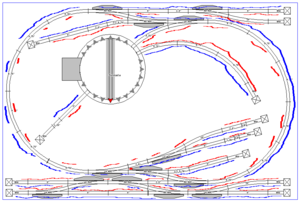Hi guys, I'm a bit confused about how to wire up my layout. There's about 24' of track crammed into a 3'x2' area with a dozen manual turnouts mostly crammed into 3 areas. I'm planning to use 22 gauge wire for the feeders. Right now I'm using a Bachmann ez command controller if that matters.
I think doing feeders to the ends of each of the sidings, in between the insulated frogs on the turnouts and at each end of those curves on the right and left side of the layout is probably more than enough.
This is part of a modular layout I'm doing. I don't need it to interoperate with other people's layouts, but I do need to be able to add connectors for that at a future date. I'm planning to use 14 gauge wire for the buss wire.
I'm not sure how best to connect the feeder wires onto the buss wire. I don't necessarily mind soldering, but I'll have a lot of wires needing to connect at the same place. And I'm eventually going to be upgrading the turnouts to use tortoise machines.
Hopefully I'm being more clear than a cup of mud.

I think doing feeders to the ends of each of the sidings, in between the insulated frogs on the turnouts and at each end of those curves on the right and left side of the layout is probably more than enough.
This is part of a modular layout I'm doing. I don't need it to interoperate with other people's layouts, but I do need to be able to add connectors for that at a future date. I'm planning to use 14 gauge wire for the buss wire.
I'm not sure how best to connect the feeder wires onto the buss wire. I don't necessarily mind soldering, but I'll have a lot of wires needing to connect at the same place. And I'm eventually going to be upgrading the turnouts to use tortoise machines.
Hopefully I'm being more clear than a cup of mud.



